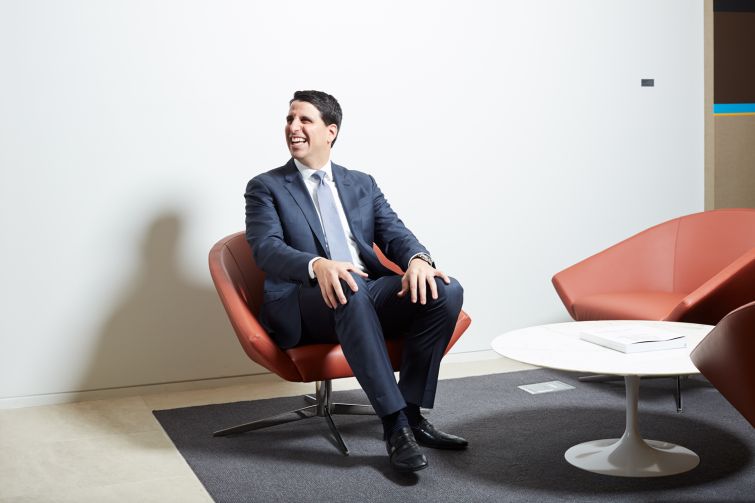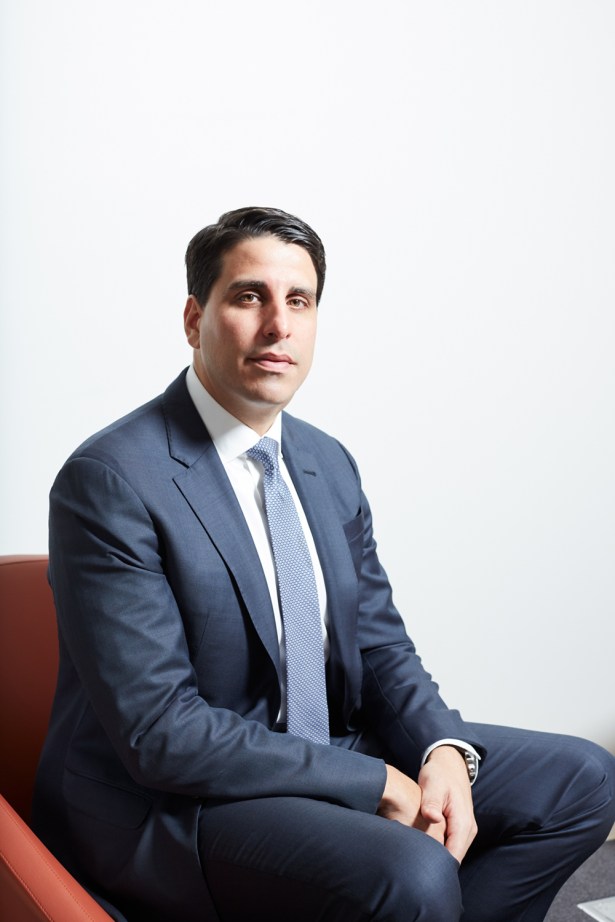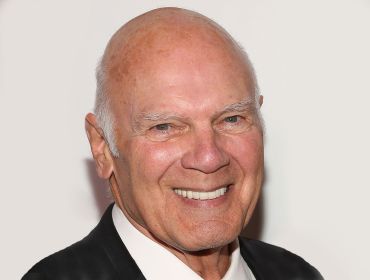Street Cred: Credit Suisse’s Stefanos Arethas on What’s Driving the CMBS Market
By Cathy Cunningham December 6, 2017 9:00 am
reprints
One has to be in good shape to scale a Suisse mountain.
Luckily, Stefanos Arethas, Credit Suisse (CS)’s head of commercial real estate loan origination, is, at only 35 years old, spry enough that he has quickly scaled the ranks at the investment bank.
Arethas’ foray into commercial mortgage-backed securities began in graduate school at Georgetown University in 2008 with a paper he authored comparing the savings and loan crisis of the 1980s and 1990s with the global financial crisis of 2008 (among the paper’s fans were Moody’s chief economist Mark Zandi)—as well as the respective market opportunities the crises produced. Fast-forward almost a decade, and Arethas is now running Credit Suisse’s loan production business alongside Matthew Masso, the bank’s head of commercial real estate finance. With $4 billion in production under their belt this year alone, the team’s recent deals include a $300 million loan on One California Plaza in Downtown Los Angeles on behalf of its purchasers, Rising Realty Partners and Colony Northstar. The seven-year loan was securitized in Credit Suisse’s single asset CSMC 2017-CALI deal.
It’s been a good year for CMBS in general. The financing source has proved its competitiveness and clawed back market share from banks’ balance sheets—so much so that issuance volume is expected to reach $90 billion in 2017 instead of the $65 billion total that most analysts foresaw at the beginning of the year. Arethas sat with Commercial Observer at Credit Suisse’s offices at 11 Madison Avenue between East 24th and East 25th Streets, and discussed his path to CMBS as well as what’s driving deal volume today.
Commercial Observer: Where are you from?
Stefanos Arethas: I’m from Charlotte, N.C. I grew up there and went to undergraduate at UNC Charlotte. I was an economics undergrad, but I had no interest in going into business—I actually wanted to go into politics.
You wanted to run for office?
Well, my first job was actually working for Erskine Bowles’ senate campaign in North Carolina—he was the former White House chief of staff. I didn’t necessarily want to run for office, but I loved the career aspects of politics and working on policy. But, the worst thing about an election is the day after it—because if you lost you’re unemployed. Not only are you trying to win the race: The next day you could be out of a job. It’s judgment day.
So, I was 23 years old and unemployed and I had to start working on a career. Charlotte is a banking town, and it was kind of the natural thing to go into banking, but when I got into [the industry] I thought it would be temporary because I wanted to get back into politics. Going back to Charlotte at the time I had offers from Bank of America, Wachovia and BB&T. I took the BB&T job because it gave me the option to be in [Washington,] D.C. Again, for me this [career move] was only going to be temporary until I got back into politics, but it kind of took off.
I worked at BB&T for six years in a portfolio lending job—so I was more like a regional banker. That allowed me to get more involved in the community and allowed me to be really connected in the D.C. market. It also allowed me flexibility to do all types of lending. I got a well-rounded experience of all of CRE, except for capital markets CMBS.
How was that path forged?
While I was at BB&T, I went to grad school at night in Georgetown. I was part of the real estate program’s inaugural class in 2008. I was waiting for my next chapter, and I thought I wanted to go into a capital markets role instead of commercial banking. The first class you take at Georgetown is an ethics class, and it was taught by Kathleen Day, who has authored many books on the savings and loan crisis. So she’s bringing in all of these characters from the crisis to talk to the class and in a matter of two weeks, the class turned from an S&L crisis discussion to the existing crisis discussion. Two weeks after I started school Lehman Brothers went down, Fannie Mae and Freddie Mac [were bailed out], AIG [collapsed] and Merrill Lynch [was acquired by Bank of America]. We were studying the S&L crisis in class, and outside it was happening all over again—with different names and different acronyms but the same. For me, that was the light-bulb moment. I saw the connection between that crisis and this crisis. And to me, it was all one big event over 30 years, not two separate crises. I made the connections as to what was going to happen when we came out of this crisis and I saw an opportunity.
What parallels did you see between the two crises?
The S&L crisis involved overbuilding and equity that was underwater. This time, it was the debt that was underwater. Understanding how we eventually recovered from the S&L crisis—I wasn’t old enough to live through that but studied it—there were really two drivers for that recovery: the [resolution trust corporation] and the ability for real estate investment trusts to go public. A lot of new tax structures were created so family real estate developers could go public. I thought to myself, during a crisis as the market is rebuilding, where can I put myself in the best position to take advantage of the next opportunity. So I said, “I’m going to write a paper on this, and hopefully I’ll get noticed.”
[The paper] was on the similarities between the two crises, and Frank Nothaft, who was the chief economist at Freddie Mac, introduced me to Mark Zandi who then read the paper and introduced me to Tad Philipp—who ran CMBS at Moody’s at the time. The next thing you know, they contacted me to say, “We’re rebuilding the group and want you to come work with us.” I thought it was a great opportunity to go into capital markets. I worked at Moody’s for just over three years, and it was a wonderful experience. In 2014, I joined Credit Suisse.
Do you still have the paper?
I do. The purpose of writing it was really to get noticed. It was the middle of the crisis, and nobody was paying attention to anyone—everybody was trying to save their own firm and save their own jobs. I was still working at BB&T and anyone who still had a job at the time moved from being a loan officer to being a workout officer. So I had that experience as well. I was lucky to be in an educational environment while also still working during a time when many people were not.
How has the real estate industry changed since then?
Investors have gotten more considerate and more careful, and that’s reflected in what we [at Credit Suisse] are able to execute in the market. Ultimately, if we think it’s a good loan, we’re going to make that loan, and whether an investor believes that or not, in theory it shouldn’t drive our decision, but we do sit in that middle seat where we’re trying to match borrowers and their capital needs with capital providers. We always have to keep an eye on both sides—that’s classic investment banking. I think the focus is on in-place underwriting and not making speculative assumptions. I also think when people look at something today, they look at how it acted before, during and after the crisis, as a good indicator for what might happen in the future.
Is there anything in the market that’s worrying you right now?
No, I think the market is in a good spot. Credit is being differentiated, and people are being rewarded and punished for making good decisions and bad decisions—so that is a reinforcing mechanism that was very evident last year and this year. We’ve never been through a period with the lack of volatility that we’ve had over the last 12 to 18 months, and I think it’s because investors are speaking clearly, and the market is reacting to that.
With your interest in policy, how do you think the regulations in the CRE market are impacting market discipline and the lack of volatility?
I think at least for CMBS the regulations that have taken place haven’t had a material impact—better or worse. We are making loans that we think are good loans on opportunities that we think are smart risks. So whether it’s [Regulation] AB changes or risk retention, I don’t think it’s changed how the CRE market is behaving.
What will the long-term impacts of risk retention be?
Initially and for the medium term I don’t see a big impact. The market has absorbed it. In the long term, it may impact liquidity, but I think that’s speculative at this point. I don’t see any impact over the next few quarters. Next time we have some volatility in the market we’ll be able to see if it matters or not, but does risk retention make [lenders] make better loans? The answer is no because at Credit Suisse we’ve always taken the position that if we can find a third party for the risk retention that’s the route we’re going to take. We have the ability to retain the risk, but if we think there’s a fair execution in the market, we’ll always go that route. So it hasn’t really changed and will not change. The loans we make, whether we’re holding [the risk retention slice] ourselves or whether we’re selling it to a third-party purchaser, our credit decision is the same.
And there are a lot of those third parties out there.
Yes. There has been a lot of money raised around events that people thought were going to create distress—risk retention, Reg AB, maturity walls…and the market has absorbed that relatively easily.

What was your deal volume like in 2017?
We are as expected, around $4 billion. I think the market as a whole is busier than we thought it would be. But in terms of the goals that Matt [Masso] and I set out at the beginning of the year around origination volumes and targets, I think we’re right where we thought we’d be.
CMBS issuance is expected to reach $85 billion to $90 billion this year, significantly more than the $65 billion to $70 billion that most analysts expected. What’s driving the increased transaction volume in the CMBS market?
The short answer is spreads, and what that does is create a reinforcing cycle. Spreads tightened, and that creates a scenario where [CMBS is] now competing with bank balance sheets and—more importantly—life companies. As spreads have come in, CMBS is more competitive on trophy office or industrial [properties]—lower leverage opportunities that may typically have gone to a life company or a pension fund. We’re now competitive in beating low-leverage pricing, so this year we won a bigger share of low-leverage opportunities. Initially it was a spread tightening that led to CMBS attracting better loans, which then produced better CMBS pools and standalone deals which then attracts more investors. It’s kind of a natural, reinforcing cycle at this point. I think we’re at a very healthy point in the market right now, and as long as CMBS is able to produce loans or deals that interest investors, I see no reason why that shouldn’t continue.
Do you predominantly issue standalone or conduit CMBS deals?
We’re always more single-borrower, standalone execution. However, we have our own shelf; we want to do our own deals, and so we will continue to do our own conduit deals. For us, if we can target a deal a quarter, or four or five deals a year—maybe six—that’s where we like to be. We don’t need to be in a position where we’re doing a deal every few weeks. The conduit business is necessary; we like the conduit business. But because of the way we think about credit, we like more strategic larger opportunities. We’ve always been more geared toward those.
Which property types do you favor or avoid?
I think the low-hanging fruit for people to pick on is retail. Matt and I still feel strongly about it. It’s going through a structural repositioning. We think there will be winners and losers, and we think we’re in a good spot to pick those winners and losers. We’re still lending on retail, a little more selectively than we were a couple of years ago, but the ship is turning slowly and retailers are evolving and adjusting. They’re waking up. Some will survive, some won’t, and there are good stories and bad stories. Just as office tenants come and go, retail tenants come and go. A few years ago Airbnb was going to destroy hotels, and now nobody is really talking about that. I suspect in a couple of years the market won’t be talking about malls in such a negative way. Retail isn’t going anywhere.
Are you focused on lending in any particular markets?
We tend to focus more on the coasts, but it’s a function of staffing for us. We run a lean, efficient team, which is why we tend to focus on larger opportunities. We evaluate every credit decision on its own merits, and we’re big on sponsors that we can view as a partner and who view us as a partner.
Do you evaluate sponsors based on their behavior in previous downturns?
Yes. That’s very important, and it doesn’t mean that someone who went through stress isn’t a good borrower. A lot of good borrowers went through stress, and whether they had kickbacks or stress in their portfolio, the question is, How did they act through that and how do certain borrowers act today? It’s a small world, and everyone knows each other.
CMBS has a bad reputation for the borrower experience: Is that changing?
It’s definitely improving, and CREFC has put together a task force to work on it. To me, it’s the number one issue affecting the growth of CMBS: the servicing. We as an industry have to fix that. We make an effort to try to structure documents and agreements with simple language, putting exhibits sometimes with the loan docs at the time of origination so the intent of the origination is there. Loan documents can be misinterpreted in the future, and so to me, that’s the No. 1 issue—servicing and how we fix that. Until we do, it’s going to be a headwind to growth. But at the same time, borrowers should understand there’s a balance. If you want the proceeds and the pricing of CMBS sometimes you have to play within the rules of CMBS.
Are pooling and servicing agreements (PSAs) improving?
I think PSAs are possibly getting more complicated. But I don’t think PSAs are the issue. I think the issue is servicers understanding that we’re in the business of lending to borrowers, and we need to do the right thing by them as well as the investors we have to answer to. There needs to be more of a balance in how servicers interpret things, and [there are issues in] the time that it takes a servicer to respond [to requests]. In some cases servicers are understaffed, but at the same time servicer compensation is thin. If we got together as an industry and said, “O.K., everyone charge one more basis point so that servicers can staff up and provide better servicing?” I don’t think anyone would care. But the issue is, Who is going to stand up and do that first? One basis point could make a huge difference. I think everyone understands the servicing concerns, and CREFC has a taskforce to address it.
What are your expectations for 2018 in terms of transaction volume?
For us, it will be a busier year, and I hope the market can maintain what it did this year. People look at the [loan] maturities and ask where the production is going to come from next year. I think we’re going to take market share back from the balance sheet banks. It was surprising to me how much market share the commercial banks took over the past two years. So, I think that going forward this will shift back towards CMBS. CMBS needs to be 25 percent plus of the market—that’s a healthy spot. The last few years it’s been between 15 and 20 percent and that has to go up to 25-plus.
How will it increase?
I think CMBS will be more competitive, and I think the servicing will get better. I think we’re going to take market share from the balance sheets.
Where will the deal flow come from?
2016 was the year we would have expected to see a lot of mergers, acquisitions and dispositions. Because of the volatility, the bid-ask on equity was too wide. With the capital markets cooperating and being constructive on the debt side this year, we were expecting a lot of the M&A activity during the second half of this year, but that didn’t materialize and got pushed into 2018. As long as the debt capital markets remain constructive, we expect M&A activity to drive the activity for 2018. It’s a good thing, as it’s fresh money going into new deals.


